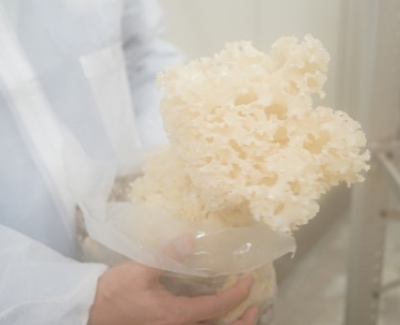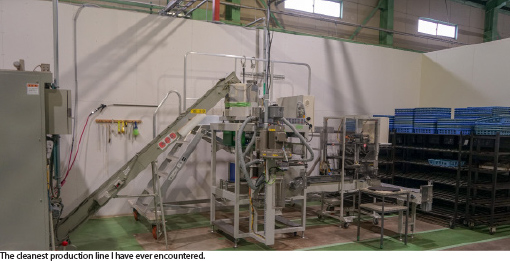Login or Subscribe
You must be logged in to access this content
Subscribe for free access to Japanese Exotic Mushroom Journal and gain insider knowledge on effective cultivation methods for Japanese mushroom species. Elevate your skills with expert tips and innovative technologies to master the art of growing Japanese exotic mushrooms.
◆ Discover exclusive Japanese mushroom cultivation techniques
◆ Learn innovative methods to enhance mushroom quality and yield
◆ Tap into Japan's rich heritage for unique growing insights
◆ Discover exclusive Japanese mushroom cultivation techniques
◆ Learn innovative methods to enhance mushroom quality and yield
◆ Tap into Japan's rich heritage for unique growing insights
Subscribe Now for Free Login
Meet the Growers
Ho-ho-ho-take, A Unique Take on Hanabiratake
The interesting point about this series is that two years in, I still have room to report on new varieties, and have yet to completely repeat a variety. Such is the depth of the industry in Japan. However, this installation of our profile on Japanese mushroom farmers is particularly special, and requires special introduction as a result. I set out to showcase a rare variety of mushroom called hanabiratake (lit. flower petal mushroom), in Japanese, but better known as cauliflower mushroom in English. The scientific name is Sparrasis crispa, and in Europe and the United States it is known as a choice edible among wild mushrooms, but difficult to clean and a rare find.In Japan, there are only three commercial growers operating at a decent scale, along with no more than a dozen extremely small specialty growers. Total national sales of hanabiratake (if I may be allowed to use the Japanese name) do not amount to more than a few hundred tons, a fairly sizeable chunk of which is used in health supplements. The story of how I came across this rare variety is also only possible in a place like Nagano Prefecture, which is the central hub of Japanese mushroom cultivation.There is a large supermarket chain, based in the same city, Komoro, as our main office, which has an exceptional selection of fresh mushrooms. This chain began stocking the hanabiratake several years ago, and as a result, I bought it to try out not long after I started a job in the mushroom business. The Japanese hanabiratake is a cool-looking mushroom, tough bracket fungus with a pale white to creamy yellow coloration. Raw or cooked it doesn’t have much of an aroma, while the texture is somewhere between cabbage and an al dente rice noodle.Along the way, I’ve ended up becoming a little bit obsessed with this variety, which has the highest percentage of beta-glucans of any edible fungi. By dry weight, hanabiratake contain roughly 50 grams of dietary fiber per 100 gram serving, of which between 30~40 grams consist of beta-glucans. It’s rich in ergosterol (which when exposed to UV light becomes Vitamin D2), and low in calories. With a history of use in traditional Chinese medicine, hanabiratake originally boomed in Japan 15 years or so ago as a health supplement, which has tapered off somewhat in recent years.An early academic study on artificial cultivation of hanabiratake using filter bags came out in 1994 and this is the earliest attempt at artificial cultivation that I can find record of, but the mushroom still has a reputation as an “illusory ingredient” even in Japan. One reason is the difficulty in growing the variety, which experts in the mushroom business have told me is so finnicky that it makes maitake look simple (and anyone reading this who grows maitake probably reread that sentence just to make sure they didn’t misunderstand), and the lack of consistency in yields and quality has made it difficult to scale up.In a sense, the mushroom market in Japan too is quite saturated, and over the past twenty years or so, since the eryngii boom peaked, it has been difficult for other new varieties to take root in the market. Thus, while artificial cultivation of hanabiratake, lion’s mane, cinnamon caps, and chestnut mushrooms has become more practical in the past twenty years, real production has only modestly inched up. As a rare mushroom, that made it very difficult to find a grower to visit.
- After several months of dead-ends and refusals, I eventually came across a most unlikely mushroom producer: a light-bulb manufacturer that specializes in car headlights, Oigawa Electric Co. LTD, a mid-sized regional supplier based in the town of Kawanehon, Shizuoka Prefecture, midway between Tokyo and Nagoya. It was such an unusual set-up that I double-checked, then tripled-checked just to make sure I wasn’t getting something wrong.The process of connecting with Oigawa Electric Company, then working out a schedule, required another month, but I finally had an opportunity to visit a hanabiratake farm in Japan in late March of 2024. From our office in Komoro City, the headquarters and factory of Oigawa Electric Company was around three and half hours drive away. On the day of my visit, the weather was lovely, with sunny clear conditions and cool spring weather that made the long drive cutting through and then around the Minami Alps a beautiful bonus.

- As far as locations go, I have had the opportunity to see many fascinating locales in Japan over the course of my journeys to visit farms and meet people working in the industry, but the town of Kawanehon has to rank high on my list. The area both reminded me, somewhat, of certain sections of Nagano Prefecture, especially the Kiso Valley. The final twenty odd minutes of driving go along a narrow, bending mountain road running alongside the Oi River. There are long stretches of wilderness and rugged mountainside, interspersed with sudden communities packed into wider bends and places where the valley spreads out.Oigawa Electric Company stands in one of the larger such bends, a community called Ieyama, not far from a train station, school, and what is more or less the central area of Kawanehon, a town which encompasses a wide swath of mountains and small hamlets. Just north is Kawane Onsen, a hot spring vacation area, and past that, the road continues to the southern end of the Minami Alps. Just at the entrance to the Ieyama area, the river and road are lined with cherry blossom trees, but I was unfortunately just a few weeks early to see the famous cherry blossom spot. I committed the idyllic scenery to memory. For those who enjoy quiet rural towns, mountains, rivers, and nature, the town of Kawanehon is perfect. A train station, and the relative closeness to several larger cities south of the town, including Shimada City and the prefectural capital, Shizuoka City, made it a very interesting location, about three hours drive from downtown Tokyo.The CEO of Oigawa Electric Company, Sasaki Takayuki (Japanese name order), sat down with me to discuss the company’s main line of business, history, and to explain the background of the hanabiratake farm. Our ninety-minute conversation began with pleasantries about the area and our self-introductions, but soon dived into one of the most interesting backdrops I have covered. Oigawa Electric Company manufacturers glass incandescent light bulbs, which, of course, work by heating a filament wire.The company’s business has historically been based in supplying Japan’s vibrant automobile manufacturing sector. The company has 105 employees, and Mr. Sasaki explained that they currently sell five to six million light bulbs a month. Beginning ten years ago, however, the company began planning for the future. The rise of new technologies has cut demand for incandescent lightbulbs and forced manufacturers to consider a long-term future where they have to make new products to survive.The biggest threat, of course, comes from LEDs: which are increasingly cheap, highly energy-efficient, and are now entering into widespread use. When I asked Mr. Sasaki why the company could not just change over to producing LEDs, he explained that the production of LED components requires enormous scales and investments far above their market capacity and resources. Otherwise, they could and do dabble in assembling LEDs on location, but in that case the price is considerably higher than LED lights made in China and the component parts are all Chinese-made, which kind of defeats the point and gives the company very little economic security and even fewer selling points.There was a slight sense of incongruousness as I spent my afternoon discussing the light bulb industry. I learned a great deal about different lighting systems and their pros and cons. Oigawa Electric Company, at least, works mainly with automakers, and most cars still use incandescent bulbs. The reason, Mr. Sasaki explained, is that LEDs themselves are cheap to produce, but require an entire electronic interface. If something happens, if the LED is damaged or ceases working, unlike an incandescent light bulb, which you can just pop in and out, an LED headlight has to have the entire component replaced.
- The first half of our conversation turned into a troubleshooting session where I attempted to guess different potential lines of business the company looked into as it evaluated long-term restructuring plans in the face of long-term market pressures. The problem the company faced was that all of its obvious options either did not have the volume to support its current size, or required enormous capital investment, or required them to enter into a well-established industry with intense competition (for instance making beakers or other glass equipment).I then immediately quipped that it was quite ironic that they ended up deciding to enter into a well-established industry with intense competition (the mushroom business), anyway. But the company, which engaged in a multi-year brainstorming project where they gathered the opinions of dozens of employees within the company and people from the community, thoroughly weighed all options. One of the first options Oigawa Electric Company considered was tea processing. Given that Shizuoka Prefecture is one of the most famous and largest tea producing areas in Japan, this was an obvious idea, however in Japan tea consumption over all has been steadily declining for a long time. In the current day, the population is shrinking, and domestically people drink far less tea daily than they did a generation ago, especially with proliferation of other drinks.In fact, right now a number of midsized processors and more and more farms continue to go out of production, something especially pronounced in Shizuoka Prefecture. This led to the next line of thought: food processing. But a basic evaluation of that industry showed that the margins are very small and it would be very difficult to compete with some of the major conglomerates that are already well-established. What would Oigawa produce? The mountainous interior of Shizuoka is not a major agricultural producer, nor are the coastal cities major seafood processing centers. The lack of a specialty meant they’d just be transporting other ingredients from a distance, and then trying to compete with big companies in established processed foods. The necessity of designing their own unique processed foods also put them back at square one in terms of business planning.However, Mr. Sasaki included, the company continued to focus on food. The goal was to formulate a long-term, sustainable business model that could continue within their current community, and which made use of their strengths. What are those strengths? As a precision manufacturer, one that largely sells to Japanese automakers (who are among the most demanding customers in the world who require extreme levels of consistency and mountains of quality control compliance), Oigawa Electric Company had deep experience managing complex processes.Mr. Sasaki outlined to me how they are very detail-oriented, used to indoor manufacturing and well-versed in mechanical problems as well as climate control systems, the latter because the climate and things like small variations in temperature and humidity are very important in the light bulb manufacturing business, given their clientele’s strict standards. I had to admit that growing mushrooms does seem like a logical diversification for a business with that kind of experience set and the availability of inexpensive land.Once they had nailed down mushrooms as an ideal product, Oigawa immediately ruled out growing any mainstream varieties. They would be running into the same problems as with food processing: extremely tight margins to start, an already saturated market, and tight competition from much larger established players. In order to expand into a new business, Oigawa wanted to build their own brand on a lesser-known mushroom variety. That way they could both sell at premium prices and have more control over the market, and also build up their facilities gradually, diffusing risk.
- Mr. Sasaki said that when he was leading the discussions, everything boiled around two points: find a rare variety that is so difficult to cultivate that no one has really figured out a reliable and efficient way to cultivate it yet. Oigawa could then study and turn its detail-oriented precision engineering mindset to the problems of cultivation and that propriety knowledge would be the underpinning of their brand and a barrier to others jumping in right after to copy them and immediate saturate the market. The second point was to try something different and unique, so they could really brand it as an “exotic mushroom” in a country where few varieties of edible mushroom have any air of novelty anymore.

- We wrapped up our conversation on that note. I appreciated just how much time Mr. Sasaki, the CEO of the company, took out of his afternoon to field questions and walk me through the long and complicated backstory that had attracted me to this farm in the first place. A gracious host to the very end, Mr. Sasaki asked me outside in the parking lot which way I had driven there, then told me that if I exited left then crossed the central bridge in the Ieyama hamlet, that the road from there was much wider and clear of construction work, which had made the road a bit harrowing at places on my way up. He then stood outside the office and saw me off, as per Japanese business etiquette.The hanabiratake farm is actually in a former factory that once processed tea. Oigawa Electric Company purchased it after the company went out of business and the refurbished the large, relatively new building into a mushroom growing facility. The farm is not in Ieyama, but rather about twenty-minutes down the mountain valley, nearer to Shimada City and the expressway. That said, the location is a little bit off the main road and feels much more isolated and quieter than its map location implied. The parking lot was small and I had to maneuver a bit to back the large company minivan into a spot just across from the sawdust shed.To the right of the farm is a wide stretch of rice fields split into dozens of parcels, altogether the size of several football fields combined, with a few scattered greenhouses visible on the edges. Outside the building, I met with a young man about the same age as me, Mr. Morishita, who is in charge of the mushroom farm. I began peppering him with questions before I’d even set my camera up, and we started from the source, as I inspected the sawdust, which is 100% Japanese larch.Japanese larch is a common tree in Japan, especially since, in the aftermath of the massive deforestation during World War II and the early postwar years, Japan engaged in a nationwide reforestation program to reduce flooding and landslide risks. Japanese larch, as a relatively fast growing tree was, along with Japanese cedar, are fast-growing in the warm, wet climate of Japan, as well as having useful properties as lumber and so were preferentially planted and remain the standard trees, along with Japanese cypress, in most tree plantations in Japan.However, I have very rarely seen Japanese larch used in mushroom farming. Shiitake, maitake, and nameko commonly use deciduous sawdust, as do wood ear mushrooms, lion’s mane, reishi, and oyster varieties. Eryngii and shimeji sometimes still use a mixture Japanese cedar sawdust with corncob and nutrition supplements, but these days both are predominantly grown on corncob substrate. Japanese larch, though, is compatible with hanabiratake cultivation and also has the benefit of being one of the most inexpensive woods on the market. This comes with pros and cons, as the number of suppliers is limited, and, in fact, Oigawa Electric Company had to change venders once already when one stopped being able to provide sawdust.Mr. Morishita mentioned that they’ve had a slight decline in yields dealing with this new sawdust, but it’s also not clear if it’s the sawdust, degradation in the spawn strain they use, or a mix of both. That’s just how sensitive and finnicky the mushroom is, which was in line with my expectations, having been told hanabiratake is even more difficult to cultivate than maitake. There are still many pieces of the puzzle they are in the process of pinning down, which is understandable given that Oigawa officially launched in 2020 and are just a little over three years into the project.

- I was really impressed hearing the full extent of different tests, combinations, and numerous adjustments that Oigawa has already made in the cultivation process. The company already has a tremendous volume of data, and continues to add to that data pool and build up the intuition and experience that helps make the best use of data in this industry. The sawdust is just one part of a very demanding process, and I even answered questions comparing their sawdust to other farms.Once inside, my first impression was that this was the cleanest mushroom farm I’ve ever been to. Clean is an understatement for how spotless the floor, the walls, the bay doors beside the mixer and the machinery were. Mr. Morishita joked that I’ve probably never seen a mushroom farm this clean, and I had to admit it was pretty impressive. He explained that, in manufacturing light bulbs, especially for automakers, the company has developed a culture of extreme cleanliness. Being clean isn’t just for the sake of it, but in the precision manufacturing sector it is a vital part of quality control. Unlike with mushrooms, manufacturing light bulbs requires equipment where a bit of dust can cause malfunctions and the smallest impurity inside the bulb can get sent back, where as a supplier, a reputation for sloppy work can lead to contracts drying up.Even proceeding into the fruiting rooms, required changing into a disposable smock, lint rollers, and a change of shoes. I was just an air shower away from the normal procedure for entering a clean room. The result spoke for itself though. For a variety of fungi that is relatively weak and more susceptible to contamination and competitor molds and bacteria than maitake, Oigawa’s fruiting rooms had no cases of contamination. The true measure of how impressive it was is that there were one or two blocks where the hanabiratake had failed to colonize the block at all, and the blocks were simply bare. The spawn hadn’t colonized the blocks, but nothing else had either. There were no Trichoderma spots, nor orangish patches of bacterial contamination. The farm has the contamination issue, a tricky one for hanabiratake, under control.The set-up was such that the incubation to fruiting occurred on a linear axis, with older blocks gradually moving further along a line of rooms as newer incubated blocks filled in from behind, with the fruiting rooms at the far end. My visit coincided with the end of March, which is when the mushroom season is already winding down in Japan, so the farm wasn’t running the same volume it did in the peak season around New Year’s.One thing that the CEO Mr. Sasaki emphasized to me was that the company understood the power of branding (an awareness I only rarely see in the Japanese industry). That was the whole point of grabbing a rare and difficult mushroom, then mastering it. The brand name of Ho-ho-ho-take is intended to be memorable and also a little playful. The packaging, which in Japan is still always plastic for mushrooms, utilizes a sharp gold center label over creamy white foreground and a clear plastic in between. The effect is an end product that has a clean and luxurious appearance.Therefore, the foremost concern of the company has been quality. Oigawa has prioritized maximizing a unique quality for their product. Because the goal is to sell at a premium as a somewhat rare, high-end mushroom, Oigawa’s process has focused on that quality first and is still in the process of working with yields and the quirky way the mushroom forms fruiting bodies. What they aim for is: 1) a very clean and pearly white fruiting body. Hanabiratake can take on a yellow or beige color really easily, so this consistent and clean-looking color is pretty important. 2) The other big selling point is the firm, crisp texture, again similar to cabbage, or to wakame seaweed.

- Mr. Morishita boasted about their quality and consistency on these points. Some of the samples I received served as proof for their claims. I happen to regularly purchase and eat hanabiratake made by one of the two other large producers in Japan, and saw the difference, both in the samples and the fruiting room. One, the color is a very clean white, not a pasty chalky white or tinged with any pale-yellow coloration. But, as someone not particularly finnicky about color as a mushroom consumer, I was more pleased with the crisp texture and broad coral-like structure. Other hanabiratake makers have an issue for me, where the fruiting body is half or more fused together into a somewhat soggy, soft block of mycelia. This just ruins the texture of the mushroom, but is apparently a frequent problem for cultivating hanabiratake.Mr. Morishita said their cultivation method is unique partially because they have solved for this particular problem. In the rare case where this kind of globular mass does form, he assured me they don’t sell it. The English phrase goes “The proof is in the pudding” and in this case, the proof was in the fruiting room. I inspected numerous blocks, which fruit from the cut-off top of the bag just like maitake do, and confirmed the consistency in the structure, coloration and firmness of the fruiting bodies.I enjoy a chance to see a mushroom farm still in the process of establishing itself. I don’t normally get to talk cultivation parameters and brainstorm. Hanabiratake is also a new enough and rare enough mushroom that it cannot be said to be solved. Take shiitake for instance, there are two main cultivation systems for shiitake, both with book-length corpuses of heavily tested and fine-toothed best practices that explicitly outline maximally efficient cultivation methods. Hanabiratake is such that we could talk about whether partially transparent or black bags would work better, whether spent shiitake logs would be an interesting amendment to the substrate and so on.While the quality was exceptional, the obvious counterpoint to both me and Mr. Morishita was the relatively small yield per block. I was particularly struck by how numerous blocks fruited without ever fully colonizing the substrate. In some cases, only around 60% of the block was colonized. I could see immediately what makes this mushroom so troublesome. How weak a fungus must be to be unable to fully colonize a well-managed substrate in the absence of any contamination pressure. Hence Mr. Morishita is beginning to study spawn, and Oigawa is considering the issue of spawn and nutrition supplementation carefully. They’ve already experimented with different levels of spent brewer’s grains (beer lees) in the substrate, in addition to their pretty standard for Japan formulation of wheat and rice bran.The flipside of these difficulties is that this is exactly what Oigawa Electric Company wanted. The more of a challenge it is to make hanabiratake into an efficient and cultivatable mushroom consistently, the more difficult it is for dozens of other farms to suddenly start growing hanabiratake and crash the price. The mushroom industry has really suffered in Japan from that boom-bust cycle, where demand starts increasing, prices look good for some variety of mushroom, then dozens of production facilities open up in a few years, production soars far faster than demand, and price (predictably) crashes. In Japan, once the price of a vegetable or mushroom decreases one time, it’s virtually impossible to ever get consumers to pay a premium for it again. For instance, the real price, in terms of actual yen, of enoki is cheaper now than it was in 1994, 30 years ago.After sharing plenty of notes and enjoying the experience, I wrapped up the tour. Mr. Morishita even apologized for not having more to show, but I assured him that the point is more to meet the people and see the fruiting rooms, even if that doesn’t take a lot of time. The nuts and bolts of cultivation are largely the same no matter what variety you look at or where you go the main difference is whether they use a bottle or bag system. The mechanics and work flow don’t change, and it doesn’t take hours to review the substrate, humidity and temperature on a farm. Five minutes in a fruiting room can tell you everything you need to know about how well a farm’s equipment works and how well they are controlling the various climate settings in the long-run.The tour gave me an interesting opportunity to experience a fresh, young start up in the Japanese mushroom business_emdash_something of exceeding rarity_emdash_on top of getting to probe one of the rarest varieties of artificially cultivated mushrooms in the world. Hanabiratake is a really cool variety that I think has great potential once more farms figure out the cultivation management. Oigawa Electric Company has taken on an interesting project, and I wish them all the luck in diversifying their business. I hope they will continue to be an economic pillar in their rural community in the mountains of northern Shizuoka Prefecture.





 1-2-13 Honmachi, Komoro city, Nagano prefecture, Japan 384-0026
1-2-13 Honmachi, Komoro city, Nagano prefecture, Japan 384-0026